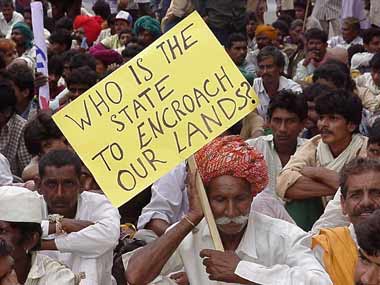The Draft National Land Acquisition and Rehabilitation & Resettlement Bill, 2011 is in the public domain. Here’s what Rural Development Minister Jairam Ramesh says on the new bill: • There is asymmetry of power and information between those wanting to acquire the land and those whose lands are being acquired. • Rehabilitation and resettlement must always, in each instance, necessarily follow upon acquisition of land. Not combining the two within one law, risks neglect of the former. • It is painfully evident that the Land Acquisition Act of 1894, despite several amendments, has become archaic. [caption id=“attachment_50873” align=“alignleft” width=“380” caption=“The archaic Land Acquisition Act of 1894, the source of all land conflicts across the country, set to get buried. Reuters”]
 [/caption] The highlights: • The government will not acquire land for private companies for private purpose. • Under no circumstances should multi-cropped, irrigated land be acquired. • The public purpose once stated cannot be changed. • Consent of 80 percent of the project-affected families is mandatory if the government acquires land for use by private companies for public purpose or public-private partnership projects other than that for national highway. • Government can invoke “urgency clause” to acquire land in the cases of national defence and security purposes, rehabilitation and resettlement (R&R) needs in the event of emergencies or natural calamities and in any “rarest of rare” cases. • Land records will also be updated and digitised to induce transparency. What’s there for land losers: • In case of urban areas, the award amount would be not less than twice the market value. • In rural areas, it would be not less that six times the original market value. • It entails subsistence allowance at Rs 3,000 per month per family for 12 months and Rs 2,000 per family as annuity for 20 years, with appropriate index for inflation. • It’s mandatory to provide employment to one member of family or Rs two lakh if a job is not offered and other incentives. • If it’s an irrigation project, land owners get one acre of land in the command area (of the project) per family. • In case of land acquisition for urbanisation, 20 per cent of developed land will be reserved and offered to the owners in proportion to the land taken. • If a tribal’s land is acquired, one acre of land should be given to each Scheduled Tribes’ family in every project. • One time financial assistance of Rs 50,000 should also be given to the ST families, whose land is taken. Implications: • Government to no more play midwife in land deals involving land owners and private players. • Misuse of the ‘urgency clause’, which facilitates acquisition of land without proper hearing and compensation, sought to be restricted. • Most of land in Punjab, Haryana, Uttar Pradesh, West Bengal and Bihar remains out of bound for acquisition. • Rehabilitation and resettlement made part of the land acquisition process. • The nexus between bureaucrats, politicians and real estate developers likely to take a hit. • The archaic Land Acquisition Act of 1894, the source of all land conflicts across the country, set to get buried. With inputs from PTI
[/caption] The highlights: • The government will not acquire land for private companies for private purpose. • Under no circumstances should multi-cropped, irrigated land be acquired. • The public purpose once stated cannot be changed. • Consent of 80 percent of the project-affected families is mandatory if the government acquires land for use by private companies for public purpose or public-private partnership projects other than that for national highway. • Government can invoke “urgency clause” to acquire land in the cases of national defence and security purposes, rehabilitation and resettlement (R&R) needs in the event of emergencies or natural calamities and in any “rarest of rare” cases. • Land records will also be updated and digitised to induce transparency. What’s there for land losers: • In case of urban areas, the award amount would be not less than twice the market value. • In rural areas, it would be not less that six times the original market value. • It entails subsistence allowance at Rs 3,000 per month per family for 12 months and Rs 2,000 per family as annuity for 20 years, with appropriate index for inflation. • It’s mandatory to provide employment to one member of family or Rs two lakh if a job is not offered and other incentives. • If it’s an irrigation project, land owners get one acre of land in the command area (of the project) per family. • In case of land acquisition for urbanisation, 20 per cent of developed land will be reserved and offered to the owners in proportion to the land taken. • If a tribal’s land is acquired, one acre of land should be given to each Scheduled Tribes’ family in every project. • One time financial assistance of Rs 50,000 should also be given to the ST families, whose land is taken. Implications: • Government to no more play midwife in land deals involving land owners and private players. • Misuse of the ‘urgency clause’, which facilitates acquisition of land without proper hearing and compensation, sought to be restricted. • Most of land in Punjab, Haryana, Uttar Pradesh, West Bengal and Bihar remains out of bound for acquisition. • Rehabilitation and resettlement made part of the land acquisition process. • The nexus between bureaucrats, politicians and real estate developers likely to take a hit. • The archaic Land Acquisition Act of 1894, the source of all land conflicts across the country, set to get buried. With inputs from PTI
Finally, UPA's promised land bill is in public domain
FP Editors
• July 29, 2011, 23:00:53 IST
The long-awaited bill is out. It has a lot of positives. But will it be the panacea for the vexed land acquisition problem in the country?
Advertisement
)
End of Article